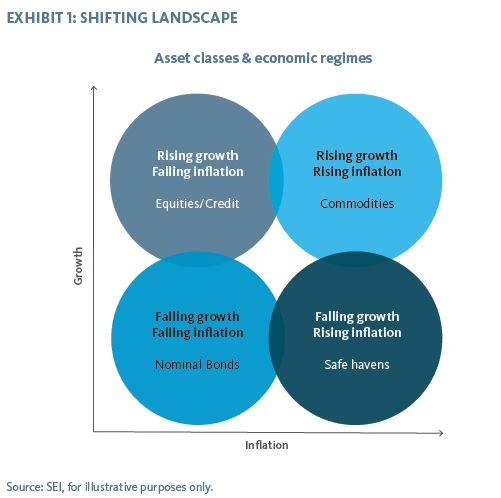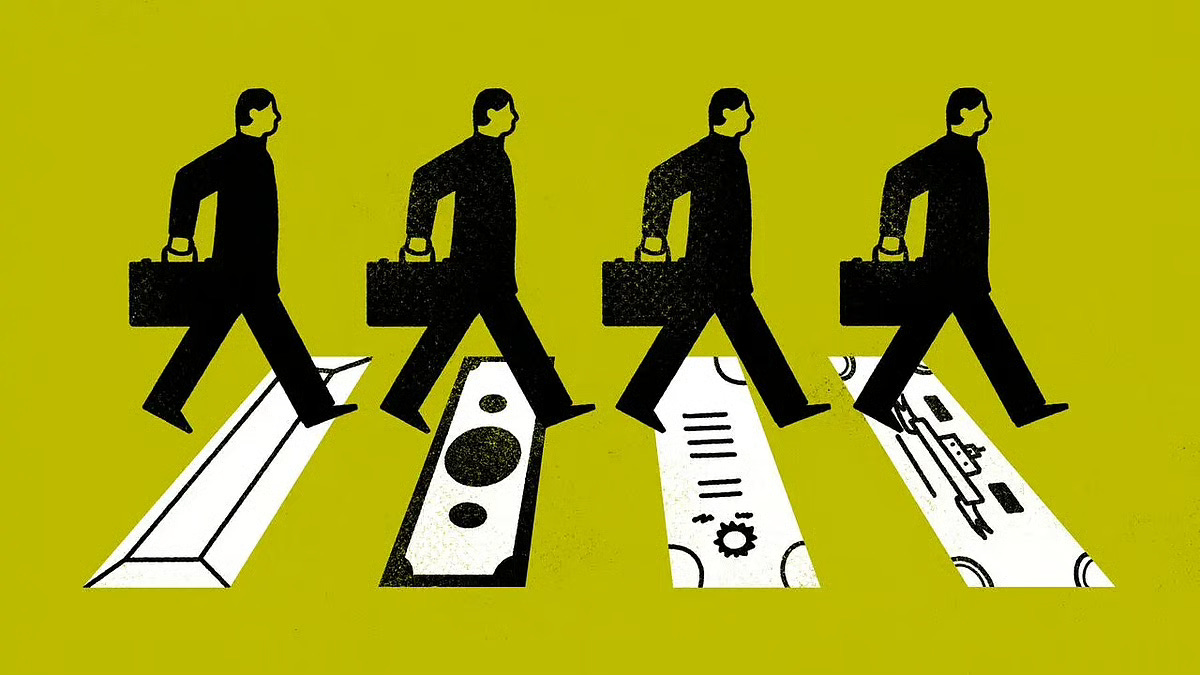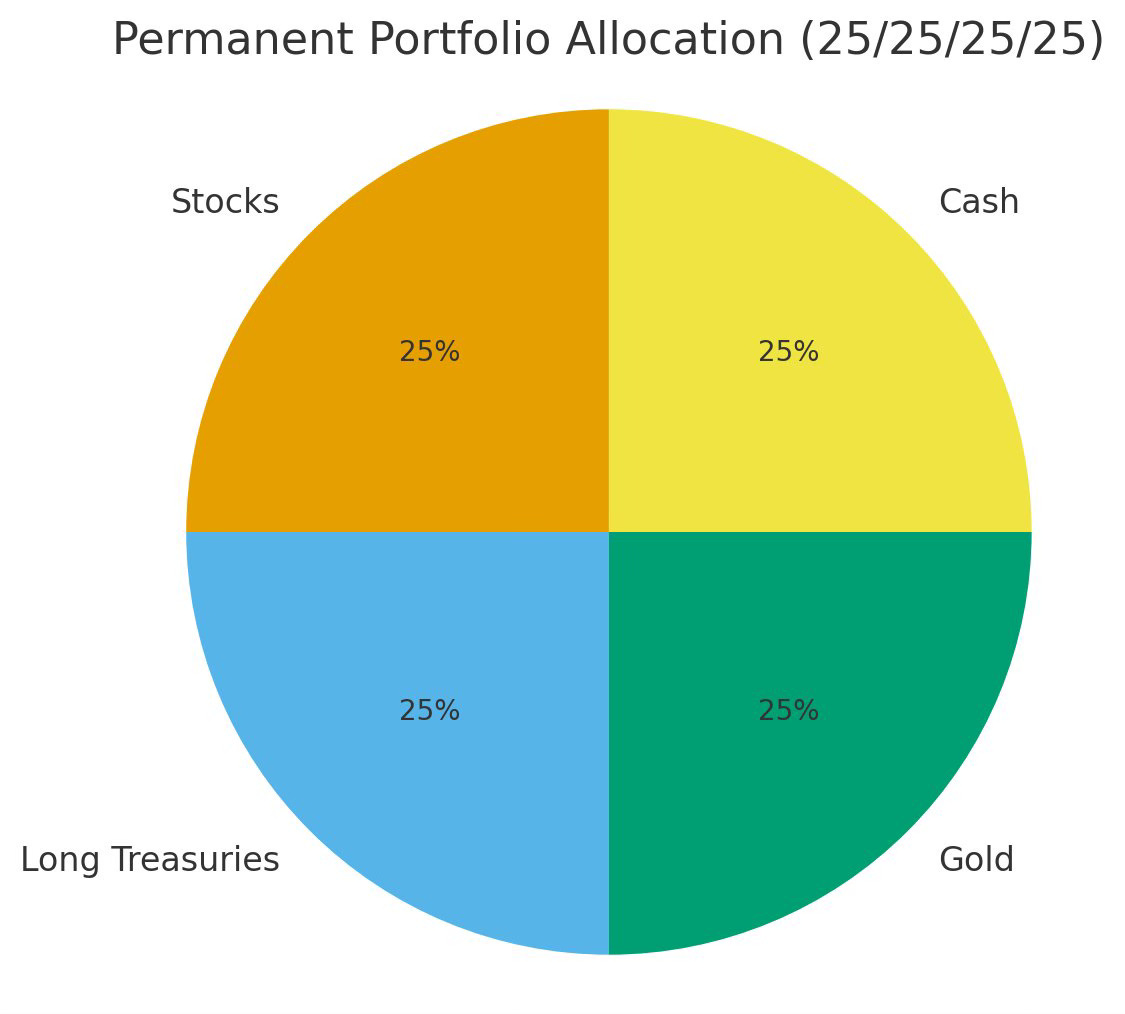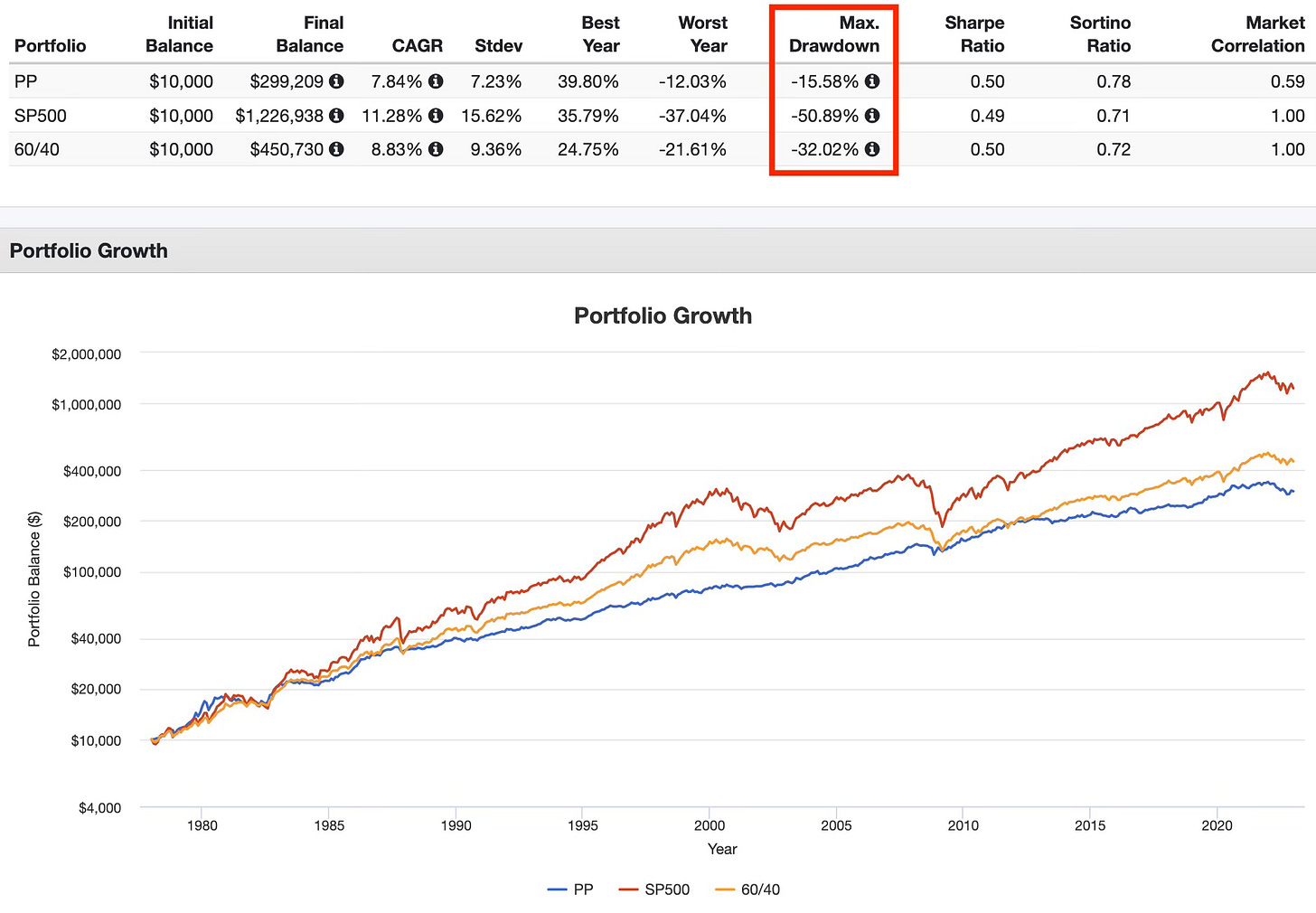How I Build my Investment Portfolio
The Permanent Portfolio is my starting point for building a lifetime-model: simplicity as the highest form of financial intelligence
There comes a time in every investor’s life when they realize that search for the perfect strategy is a never-ending quest. Every new financial fad promises efficiency, returns, diversification and every market cycle gives rise to and then buries theories, gurus and miracle cures. But on closer inspection, great ideas never grow old. They remain there, as pillars of common sense and method, reminding us that simplicity is often the highest form of intelligence. «Harry Browne’s Permanent Portfolio» belongs squarely in this category and is one of those ideas not only works but also teaches.
This is my starting point with my clients, before designing and building a tailor-made suit for their investment goals.
C’è un momento nella vita di ogni investitore in cui ci si accorge che la ricerca della strategia perfetta è una corsa senza fine. Ogni nuova moda finanziaria promette efficienza, rendimento, diversificazione e ogni ciclo di mercato fa nascere e morire teorie, guru, ricette miracolose. Ma a ben guardare, le grandi idee non invecchiano mai. Restano lì, come colonne portanti di buon senso e di metodo, a ricordarci che la semplicità è spesso la forma più alta di intelligenza. Il «Portafoglio Permanente di Harry Browne» appartiene pienamente a questa categoria ed è una di quelle idee che non si limitano a funzionare, ma insegnano.
E questo è il mio punto di partenza che adotto con i miei clienti, prima di modellare e costruire un vestito su misura per i propri obiettivi di investimento.
The fundamentals of the «Permanent» model
Harry Browne was not a manager, academic, or analyst in the conventional sense of term. He was rather a man of thought, an observer of society and economy, gifted with profound lucidity and an almost ethical respect for individual freedom. In the United States of the 1970s, amid runaway inflation, oil crises, and a widespread sense of distrust in economic institutions, Browne asked himself a question that might have seemed naive but turned out to be brilliant: is it possible to build a portfolio that works all the time, regardless of what happens?
In other words, can an investor be protected, safe and profitable even without being able to predict the future? That question gave rise to the «Permanent Portfolio», a construct of disarming simplicity but profound, almost philosophical logic.
Browne started from the observation that economic life, after all, moves in large cycles, and general world conditions such as inflation, growth, deflation and crisis tend to repeat themselves, albeit with varying intensity and in different forms. Each phase rewards certain types of investment and penalizes others. The mistake of the average investor is to believe they can know in advance which phase will come next. Browne, with disarming humility, chose not to even try. He preferred to build a structure could adapt naturally, like a sail that changes angle with the wind, without the need for constant adjustments. The result was a portfolio divided into four equal parts:
stocks, which embody growth, confidence in human progress and private initiative;
long-term bonds, which protect the portfolio in times of recession and falling interest rates, when money tends to seek refuge in security;
gold, the universal hedge against inflation, currency collapse and loss of confidence in monetary systems;
liquidity, which represent prudence, immediate availability, and ability to survive in times of panic.
Four instruments, four worlds, four seasons of the economy, each balanced by the other. The genius lay not so much in the choice of instruments themselves as in the way they interacted with each other. When economy was growing and stock markets were booming, 25% invested in equities guaranteed a return. When growth degenerated into inflation, it was gold that protected capital. If, on the other hand, fear took over and interest rates fell, long-term bonds rose in value, offsetting stock losses. And in the darkest moments, when everything seemed to be collapsing, liquidity became the natural refuge.
It was an almost organic system, in which each part lived in balance with the others. A small financial ecosystem capable of self-regeneration. Browne called it «permanent» not because it was immutable, but because its logic was independent of fads, economic conditions and forecasts. Investors no longer had to be seers, but only custodians. All it took was a periodic rebalancing once a year, with the calmness of someone tidying up their drawers, to bring the weight of each component back to 25%. It was an almost Zen-like discipline: selling what had gone up, buying what had gone down, without emotion, without comment, without pretending to know more than the market.
Le basi del modello «Permanente»
Harry Browne non era un gestore, né un accademico, né un analista nel senso convenzionale del termine. Era piuttosto un uomo di pensiero, un osservatore della società e dell’economia, dotato di una profonda lucidità e di un rispetto quasi etico per la libertà individuale. Negli Stati Uniti degli anni Settanta, tra inflazione fuori controllo, crisi petrolifere e un senso diffuso di sfiducia nelle istituzioni economiche, Browne si pose una domanda che avrebbe potuto sembrare ingenua ma che si rivelò geniale: è possibile costruire un portafoglio che funzioni in ogni momento, indipendentemente da ciò che accade?
In altre parole, può un investitore essere protetto, sereno e profittevole anche senza saper prevedere il futuro? Da quella domanda nacque il «Permanent Portfolio», una costruzione di una semplicità disarmante ma di una logica profonda, quasi filosofica.
Browne partiva dall’osservazione che la vita economica, in fondo, si muove per grandi cicli, e che le condizioni generali del mondo quali inflazione, crescita, deflazione, crisi, tendono a ripetersi anche se con intensità e forme diverse. Ogni fase premia alcuni tipi di investimento e ne penalizza altri. L’errore dell’investitore medio è credere di poter sapere in anticipo quale fase arriverà. Browne, con disarmante umiltà, scelse di non provarci nemmeno. Preferì costruire una struttura che fosse in grado di adattarsi naturalmente, come una vela che cambia inclinazione col vento, senza bisogno di correzioni continue. Il risultato fu un portafoglio diviso in quattro parti uguali:
azioni, che incarnano la crescita, la fiducia nel progresso umano e nell’iniziativa privata;
obbligazioni a lungo termine, che proteggono il portafoglio nei momenti di recessione e di calo dei tassi, quando il denaro tende a rifugiarsi nella sicurezza;
oro, la copertura universale contro l’inflazione, il crollo delle valute e la perdita di fiducia nei sistemi monetari;
liquidità, che rappresenta la prudenza, la disponibilità immediata e la capacità di sopravvivere nei momenti di panico.
Quattro strumenti, quattro mondi, quattro stagioni dell’economia, ognuna bilanciata dall’altra. La genialità non era tanto nella scelta degli strumenti in sé, quanto nel modo in cui interagivano tra loro. Quando l’economia cresceva e i mercati azionari correvano, il 25% investito in azioni garantiva rendimento. Quando la crescita degenerava in inflazione, era l’oro a proteggere il capitale. Se invece la paura prendeva il sopravvento e i tassi d’interesse scendevano, le obbligazioni a lungo termine salivano di valore, compensando le perdite azionarie. E nei momenti più bui, quando tutto sembrava crollare, la liquidità diventava il rifugio naturale.
Era un sistema quasi organico, in cui ogni parte viveva in equilibrio con le altre. Un piccolo ecosistema finanziario in grado di auto-rigenerarsi. Browne lo chiamò «permanente» non perché fosse immutabile, ma perché la sua logica era indipendente dalle mode, dalle congiunture e dalle previsioni. L’investitore non doveva più essere un veggente, ma solo un custode. Bastava un ribilanciamento periodico una volta all’anno, con la calma di chi mette ordine nei propri cassetti, per riportare il peso di ogni componente al suo 25%. Era una disciplina quasi zen: vendere ciò che era salito, comprare ciò che era sceso, senza emozioni, senza commenti, senza la pretesa di sapere più del mercato.
Results and principles behind the «Permanent Portfolio»
Historical results have shown this philosophy works. From 1972 to the present, the «Permanent Portfolio» has delivered average annual returns of between 7% and 8%, with low volatility and, above all, much more modest drawdowns than traditional portfolios. In major crises, from the crash of 1987 to the tech bubble of 2000, from the crisis of 2008 to the pandemic, Browne’s model has always shown surprising resilience: it didn’t shine in moments of euphoria, but neither did it collapse in moments of fear. And that, over time, is what really matters.
The most fascinating aspect of the Permanent Portfolio, however, is not its numerical performance, but philosophy it embodies. It is an act of intellectual humility, a recognition of human limitations in forecasting, an invitation to discipline and patience. Browne argued that personal finance should not be a constant search for prophecies, but a form of self-defense. «Your portfolio should be constructed so that it survives even if you get everything wrong», he wrote. And this seemingly paradoxical statement contains the key to profound wisdom.
In a sense, Permanent Portfolio is the financial version of the principle of anti-fragility: a system not only withstands shocks, but draws strength from them. Every economic crisis, every geopolitical shock, every inflationary or deflationary cycle becomes an opportunity for another part of the portfolio to shine. It is a structure adapts, breathes, doesn’t need to predict because it knows how to react.
Many have tried over time to improve it, to make it more modern, to add a real estate component, to replace liquidity with more profitable monetary instruments, or to modify the weights according to the context. But truth is that any change alters its original spirit. Browne’s portfolio is not a mathematical mechanism, it is a philosophy of balance, and like any balance, it works precisely because it accepts that it is imperfect.
I risultati e i principi dietro il «Portafoglio Permanente»
I risultati storici hanno dimostrato che quella filosofia funziona. Dal 1972 a oggi, il «Portafoglio Permanente» ha offerto rendimenti medi annui tra il 7% e l’8%, con una volatilità contenuta e, soprattutto, con drawdown molto più modesti rispetto ai portafogli tradizionali. Nelle grandi crisi, dal crollo del 1987 alla bolla tecnologica del 2000, dalla crisi del 2008 alla pandemia, il modello di Browne ha sempre mostrato una capacità di tenuta sorprendente: non brillava nei momenti euforici, ma nemmeno crollava nei momenti di paura. E questo, nel tempo, è ciò che davvero conta.
L’aspetto più affascinante del Portafoglio Permanente non è però la performance numerica, ma la filosofia che incarna. È un atto di umiltà intellettuale, un riconoscimento dei limiti umani nella previsione, un invito alla disciplina e alla pazienza. Browne sosteneva che la finanza personale non dovesse essere una continua ricerca di profezie, ma una forma di auto-difesa. «Il tuo portafoglio deve essere costruito in modo da sopravvivere anche se sbagli tutto», scriveva. E questa frase, apparentemente paradossale, contiene la chiave di una saggezza profonda.
In un certo senso, il Permanent Portfolio è la versione finanziaria del principio di antifragilità: un sistema che non solo resiste agli urti, ma che ne trae forza. Ogni crisi economica, ogni shock geopolitico, ogni ciclo inflattivo o deflattivo diventa un’occasione per un’altra parte del portafoglio di brillare. È una struttura che si adatta, che respira, che non ha bisogno di predire perché sa reagire.
Molti hanno tentato nel tempo di migliorarlo, di renderlo più moderno, di aggiungervi una componente immobiliare, di sostituire la liquidità con strumenti monetari più redditizi, o di modificare i pesi in funzione del contesto. Ma la verità è che ogni variazione ne altera lo spirito originario. Il portafoglio di Browne non è un meccanismo matematico, è una filosofia di equilibrio, e come ogni equilibrio, funziona proprio perché accetta di essere imperfetto.
Browne’s model applied to modern times
Its relevance today is even greater than when it was first conceived. We live in an era of structural uncertainty: parabolic post-pandemic inflation after decades of absence, interest rates recently falling after a period of steady growth and a generation of almost free money, permanent geopolitical tensions, hyper-connected markets vulnerable to collective emotions. In this context, a simple, transparent, understandable and resilient portfolio is a valuable compass.
For a financial advisor, Browne’s model can be the fundamental on which to build any more sophisticated architecture. Not as dogma, but as a foundation. It means teaching clients diversification is not about putting together many different instruments, but instruments behave differently in different economic phases. It means educating them about consistency, emotional management and understanding their relationship with risk. Whenever markets move violently, the average investor reacts with panic or euphoria. The Permanent Portfolio, on the other hand, forces a different stance: that of someone who knows everything has its place and every phase of the market makes sense within a larger design. It is a way to defuse fear and greed, two forces more than any other ruin long-term results.
Of course, such a portfolio will never make the investor the star of glossy magazine covers or social media discussions. It will not make them dream of double-digit gains in a few months, but it will give them something much more valuable: peace of mind. Knowing that your money is protected, every scenario has been considered, there is no need to chase the latest trend or the latest thematic ETF. It is, after all, a way of restoring finance to its original function: protecting the freedom and time of individual.
When you look at the simplicity of the Permanent Portfolio, you almost feel like you are looking at a natural principle, like a law of physical equilibrium. Everything that grows too much is offset by what remains stable, and everything that falls too much creates opportunities for what rises again. It is a continuous cycle of compensation, a dance between risk and prudence, between growth and protection. And it is precisely this harmony that makes it, paradoxically, «permanent». Perhaps this is why, more than fifty years later, his lesson resonates even more strongly today. In the world of contemporary finance, where technology accelerates every decision and information flows push towards reactivity, Browne invites us instead to slow down. To build a strategy not on the anxiety of predicting, but on the awareness of resisting.

Il modello di Browne applicato ai tempi moderni
La sua attualità, oggi, è persino maggiore che ai tempi in cui fu concepito. Viviamo in un’epoca di incertezza strutturale: inflazione post-pandemica parabolica dopo decenni di assenza, tassi recentemente in discesa dopo una fase di crescita costante e una generazione di denaro quasi gratuito, tensioni geopolitiche permanenti, mercati iper-connessi e vulnerabili alle emozioni collettive. In questo contesto, un portafoglio semplice, trasparente, comprensibile e resiliente rappresenta una bussola preziosa.
Per un consulente finanziario, il modello di Browne può essere la base su cui costruire qualsiasi architettura più sofisticata. Non come dogma, ma come fondamento. Significa insegnare al cliente che la diversificazione non è mettere insieme tanti strumenti diversi, ma strumenti che si comportano diversamente nelle diverse fasi economiche. Significa educare alla costanza, alla gestione emotiva, alla comprensione del proprio rapporto con il rischio. Ogni volta che i mercati si muovono con violenza, l’investitore medio reagisce con panico o euforia. Il Permanent Portfolio, invece, costringe a una postura diversa: quella di chi sa che ogni cosa ha un suo posto, e che ogni fase del mercato ha un senso all’interno di un disegno più ampio. È un modo per disinnescare la paura e la cupidigia, le due forze che più di ogni altra rovinano i risultati nel lungo periodo.
Certo, un portafoglio del genere non renderà mai l’investitore il protagonista delle copertine patinate o delle discussioni sui social. Non farà sognare con guadagni a doppia cifra in pochi mesi, ma gli darà qualcosa di molto più prezioso: la pace mentale. Sapere che il proprio denaro è protetto, che ogni scenario è contemplato, che non serve correre dietro all’ultima moda o all’ultimo ETF tematico. È, in fondo, un modo per restituire alla finanza la sua funzione originaria: proteggere la libertà e il tempo dell’individuo.
Quando si osserva la semplicità del Portafoglio Permanente, si ha quasi la sensazione di trovarsi di fronte a un principio naturale, come una legge di equilibrio fisico. Tutto ciò che cresce troppo viene compensato da ciò che rimane stabile, e tutto ciò che scende troppo crea opportunità per ciò che risale. È un ciclo continuo di compensazione, una danza tra rischio e prudenza, tra crescita e protezione. Ed è proprio questa armonia a renderlo, paradossalmente, «permanente». Forse è per questo che, a distanza di oltre cinquant’anni, la sua lezione risuona ancora più attuale. Nel mondo della finanza contemporanea, in cui la tecnologia accelera ogni decisione e i flussi informativi spingono verso la reattività, Browne ci invita invece alla lentezza. A costruire una strategia non sull’ansia di prevedere, ma sulla consapevolezza di resistere.
Conclusions and personal reflections
Ultimately, the Permanent Portfolio is more than an investment strategy: it is a form of financial education, a school of patience and balance. It is a silent reminder of what really matters: not how much you earn in a year, but how much you manage to keep intact throughout a lifetime of investing. It is a model teaches you to think like a custodian, not a speculator; to defend before attacking; to choose serenity over adrenaline. Harry Browne has left us a legacy needs no updating: its strength lies precisely in its immutability. It is a manifesto of financial freedom, an invitation not to delegate your peace of mind to the forecasts of the day, but to build it on solid, clear and understandable fundamentals. And perhaps, if there is one truth runs through all cycles, it is this: in finance as in life, simplicity stands the test of time.
In my daily work as a financial advisor, principle that is fundamental to the Permanent Portfolio is something I recognize, live by, and apply every day, even when I don’t explicitly mention it. Not because I believe structure should be replicated literally, but because I share its spirit. Every well-constructed portfolio, today as then, is born from a balance between return and protection, between ambition and prudence, between desire to grow and the need to remain solid. After all, what I do with my clients is not very different from what Browne did with his readers (with all due respect, ed.): helping them free themselves from the need to predict and guiding them towards the awareness that strength of an investment lies in its consistency over time, not in the brilliance of the moment.
When I talk about strategies, markets, scenarios, or portfolio construction on DTI, I never try to propose a definitive truth. Rather, I try to educate people about a method. And Browne’s method, rational calm, trust in simple principles, discipline that prefers stability to euphoria, is the same you should guide every responsible investment path. A portfolio should not impress: it should last, it should not amaze but resist. And it is precisely in this balance between ambition and lucidity the true value of time is built, which is the only truly irreversible capital.
In a world that is changing at an increasing speed, Harry Browne’s message remains, for me, a silent beacon: we cannot predict, but can prepare. And preparing, in finance as in life, means building solid fundamentals, choosing tools that make sense and giving time its rightful role. This is the ground on which I try to work every day, and it is from this philosophy that my approach to consulting is born, not as a promise of return, but as a project of balance.
Conclusioni e riflessioni personali
In definitiva, il Portafoglio Permanente è più di una strategia d’investimento: è una forma di educazione finanziaria, una scuola di pazienza e di equilibrio. È un promemoria silenzioso di ciò che conta davvero: non quanto si guadagna in un anno, ma quanto si riesce a mantenere intatto lungo tutta una vita d’investimenti. È un modello che insegna a pensare come un custode, non come uno speculatore; a difendere prima ancora di attaccare; a scegliere la serenità al posto dell’adrenalina. Harry Browne ci ha lasciato un’eredità che non ha bisogno di aggiornamenti: la sua forza sta proprio nella sua immutabilità. È un manifesto di libertà finanziaria, un invito a non delegare la propria tranquillità alle previsioni del giorno, ma a costruirla su basi solide, chiare e comprensibili. E forse, se c’è una verità che attraversa tutti i cicli, è proprio questa: nella finanza come nella vita, la semplicità resiste al tempo.
Nel mio lavoro quotidiano di consulente finanziario, il principio che sta alla base del Portafoglio Permanente è qualcosa che riconosco, vivo e applico ogni giorno, anche quando non ne parlo esplicitamente. Non perché io creda che quella struttura debba essere replicata alla lettera, ma perché ne condivido lo spirito. Ogni portafoglio ben costruito, oggi come allora, nasce dall’equilibrio tra rendimento e protezione, tra ambizione e prudenza, tra il desiderio di crescere e la necessità di restare solidi. In fondo, quello che faccio con i miei clienti non è molto diverso da ciò che Browne fece con i suoi lettori (con il dovuto rispetto, ndr): aiutarli a liberarsi dal bisogno di prevedere, e accompagnarli verso la consapevolezza che la forza di un investimento sta nella sua coerenza nel tempo, non nella brillantezza del momento.
Quando parlo di strategie, di mercati, di scenari o di costruzione di portafogli su DTI, non cerco mai di proporre una verità definitiva. Cerco, piuttosto, di educare a un metodo. E il metodo di Browne, quella calma razionale, quella fiducia nei principi semplici, quella disciplina che preferisce la stabilità all’euforia, è la stessa che dovrebbe guidare ogni percorso di investimento responsabile. Un portafoglio non deve impressionare: deve durare, non deve stupire ma resistere. Ed è proprio in questo equilibrio tra ambizione e lucidità che si costruisce il vero valore del tempo, che è l’unico capitale davvero irreversibile.
In un mondo che cambia a velocità crescente, il messaggio di Harry Browne rimane, per me, un faro silenzioso: non possiamo prevedere, ma possiamo prepararci. E prepararsi, in finanza come nella vita, significa costruire basi solide, scegliere strumenti che abbiano senso, dare al tempo il ruolo che gli spetta. È su questo terreno che cerco di lavorare ogni giorno, ed è da questa filosofia che nasce il mio modo di fare consulenza, non come promessa di rendimento, ma come progetto di equilibrio.





